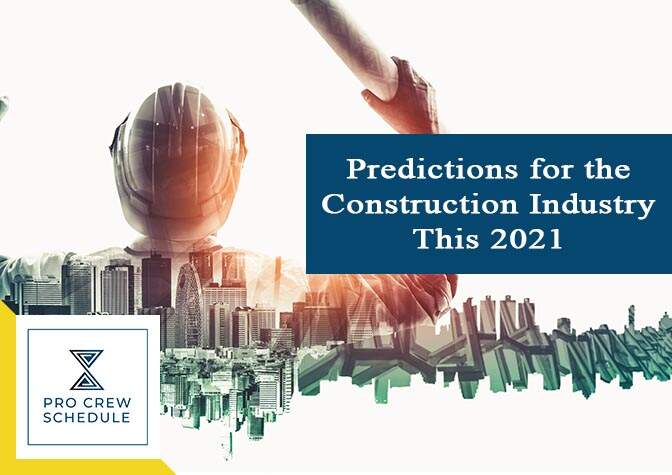The year 2020 has been challenging for the construction industry, which requires workers to be physically present at the site for a project to be done. The ongoing global crisis has brought unprecedented disruption to building projects until later this year when the country has become accustomed to the new normal way of working.
This upcoming year, though, it is expected that the industry will be back on track with new trends like remote working, the shift of resources, living materials, and so much more to support the contractors.
Here are our eight bold predictions on what are the new trends and innovations for the construction industry this coming 2021
1. Use of Living Construction Material
Living microorganisms have now become a vital ingredient in raw construction materials. While they have been dreaded in the past because of the idea that they may damage structures, new materials technology has found the right bacteria and fungi that would rather enhance buildings’ durability.
Following this discovery, numerous concrete manufacturers are using different bacterias to improve the quality of their products. The bacterias they use are reportedly capable of living in the pores of the concrete.
Self-mending or self-healing concrete is saturated with bacteria that can bind materials surrounding it and create a new structural material. This new material used by concrete contractors grows in the pores of the concrete to add to its impermeability. This characteristic of self-healing concrete makes it a perfect remedial material for fissures and cracks without much supervision as they repair on their own. While its purpose has been limited to repairs in the past, today and in the coming years, self-healing concrete in usable shapes and sizes will be developed as a new in-demand material for constructing buildings.
Mycelium composites are another living microorganism used as ingredients in making innovative construction materials. Instead of bacteria, fungi are used to produce materials that are already replacing traditional construction materials like engineered wood and synthetic foams. Mycelium composites have high fire safety properties and acoustic absorption characteristics. They are usually used in flooring, paneling, insulation, door cores, and cabinetry.
More types of fungi and bacteria are expected to be used in the coming years to create materials that can significantly improve the durability of the buildings.
2. Remote Construction Technology
“Remote work” has been used mostly for project management for construction only. Through software, project managers are able to execute their construction crew management responsibilities without being at the site. Contractors are also able to collaborate with stakeholders virtually online. Digitalization has streamlined a lot of crucial processes and will continue to be the trend in the upcoming years.
However, as a higher level of health safety is being required in the construction industry, the industry is poised to discover other activities at the site that can be done remotely.
The use of drones, automated machines, remote-controlled equipment, robots, IoT, and reality technologies will be realized by more companies as safety becomes the industry’s ultimate concern. Since the ongoing crisis can cripple a whole team, companies are bound to rely on these technologies to push through with their projects while avoiding insurance claims.
3. 3-D Printing
This technology has been dramatically reducing on-site worker density in the past years. Because of the ongoing labor shortage, the industry has leaned towards 3D printing for constructing major building components and even a whole structure. Months of work have been cut down to a week and has become a quicker solution than modular construction.
In fact, this method is now used in different parts of the world to build commercial structures. Some countries like Mexico are even using 3D printing for building an entire neighborhood.
This 2021, more companies are bound to consider this method as the problem of labor shortage is expected to worsen. It will also become a preferred complementary construction method to speed up the project and to make custom elements more affordable.
4. Modular Construction
Like 3D printing, modular construction is a way to reduce on-site worker density. This method is already being widely used in the industry, but its relevance will be appreciated in the upcoming year as worker distancing is required.
More building parts are then expected to be manufactured indoors and installed using cranes, lifts, conveyors, and trucks, which can all be controlled remotely. Systems to support modular construction will be updated to accommodate more companies looking into using prefabricated building elements.
Furthermore, collaborative tools to connect the general contractor with the manufacturer will be developed so factory visits will be minimized while seeing that the flow of data will be uninterrupted. This is crucial as clients tend to request changes even when the project is already ongoing and contractors wouldn’t want to reorder and re-deliver parts repeatedly as it will be costly to do so.
5. Building Information Modeling & Virtual Design and Construction
BIM has already been a popular design technology in the construction industry for the past decade. In fact, its enhancement has quickly replaced CAD as the drawing program used by architects and civil engineers. Today, even tradespeople are relying on BIM to create more efficient designs.
This software had made construction in virtual space possible before construction in real life and used this technology to detect potential pitfalls that may arise due to design flaws. BIM or VDC can also pinpoint difficult connections, allowing designers to revise the drawing to make construction easier and faster. Overall, it serves as a smart program to rethink the design and construction process whenever an issue is detected from the current data.
These capabilities’ relevance during these times effectively minimizes the need to stay longer in the site to analyze what process should come next or what solutions to be applied when problems occur. This then keeps the crew members safer and managing construction a lot simpler.
6. Delays in Projects
The global health concern has caused the spending in a lot of countries to decline. That includes getting the services of contractors and subcontractors for building new residential and non-residential buildings. Consequently, finance companies slowed down in lending capital to construction companies, particularly to borrowing for large projects.
The AIA expects the decline in spending on non-residential buildings to continue this coming 2021. Spending on infrastructure projects is also expected to be delayed. The private industrial sector is already seeing a slowdown in building new projects. More plans may be pushed back too until the world recovers from its current health crisis.
For the ongoing projects, as it is already required to maintain worker distance, the execution of tasks is becoming slower, especially when the industry was caught by surprise and wasn’t able to prepare for the new standard working method. Although numerous technologies can make up for the delay, like robotics and automation, many firms are not yet with these technologies. Hence their projects will undoubtedly see delays.
7. Mechanic’s Lien for Payment Disputes
Money has always been a complicated issue in the construction industry since a single project can involve millions of dollars in the deal. Both clients and contractors face the fate of bankruptcy and it becomes more inevitable now that the world is struggling economically.
Disputes may lead to lawsuits, but mechanic’s liens will likely become the trend to settle money matters between the building owners and the contractors.
Contractors and subcontractors have used mechanic’s liens to claim a portion of the property built, serving as a guarantee for collecting payment owed. We’ve seen many projects resort to this for settling payment disputes and usually, the Notice of Intent to file mechanic’s lien resolves the issue. In cases where the lien was ultimately filed, parties seldom experienced foreclosure, as they find opportunities for resolution along the way.
However, with more payments likely to be disrupted (remember we said that companies might find it hard to secure a construction loan this coming year), contractors may fall into the idea of selling a claim. In fact, offering cash upfront for lien claims to contractors already started.
8. Alternative Supplies
With difficulty to have materials shipped from abroad these days, contractors will be forced to find alternative supplies and if not, they might need to pay much higher for the materials they need. This means that costs will shoot up and bigger capitals will be needed. With financing becoming more difficult to secure, the only way is to use available resources in the country. Fortunately, there are many manufacturers of quality construction materials in the U.S. too.
New construction projects might start from scratch when it comes to defining costs, as they are certainly going to increase due to new supplier partnerships. Ongoing projects might need to revise current contracts to discuss unforeseen cost increases. This, however, allows US suppliers to build lasting relationships with US builders, and we may see a lower material cost in the long run as shipping fees and taxes will be eliminated.
Key Takeaways
We can never really tell what the construction industry will exactly look like in the year 2021, but with what’s going on today, we need to be ready for these situations that are likely to happen. With this as a guide, managing construction in the new year shouldn’t be too risky.







